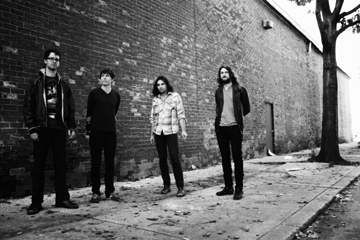Spotlight: The War on Drugs

In the book The Poetics of Rock, Albin Zak examines sound recording’s influence on the way that people make and perceive music. The idea is that studio recordings introduced a new dimension of musical composition, which altered the conceptual landscape of musical culture, but also offered a new poetic mode to present it in.
Another dimension was introduced in 1979 when TASCAM invented the Portastudio – the first four-track recorder to utilize a compact cassette tape – which spawned the school of home recording, allowing musicians a medium to present their art without ever having to pay for studio time. The War on Drugs’ Adam Granduciel is a student of this school, and, in many ways, his band’s latest album Slave Ambient has redefined some of its teachings.
Through years of experimenting with various home recording techniques and sampling methods, Granduciel has learned to build galactic soundscapes using synth drones and colorful ambient textures that flow in the undercurrent beneath many of his soaring rock anthems. Combining the vocal styles of American heroes like Dylan and Springsteen with post-punk guitar lines and motorik drumbeats, he creates what he describes as “classic rock fed through a broken digital ‘80s reverb unit.”
Granduciel’s foray into the world of home recording started to take shape when he moved to Philadelphia in 2003 and began to play with local musicians such as fellow soundscaper Kurt Vile.
“When we first started, we never recorded the songs – it was just a learning process,” he says. “We weren’t recording a record – we were fucking around making crazy noises and looping guitars.”
Without a defined project of his own, Granduciel hooked up with local indie band The Capitol Years – whose lineup featured future Drugs bassist Dave Hartley on guitar – and went on tour because he was working at “a shitty job” and “they needed someone to play bass.”
During the next five or six years, a rotating cast of musicians from Granduciel’s recording projects came and went until they completed a series of demos, which the influential indie label Secretly Canadian picked up and released as the Barrel of Batteries EP in 2008.
Later that year, The War on Drugs released their full-length debut, Wagonwheel Blues, featuring the group’s American rock sound more prominently than on their experimental underbelly, while still hinting at the sonic direction that they would aim to emulate in their follow-up.
It took Granduciel three years to create Slave Ambient, a project that was largely the result of studio experiments and discoveries. “It comes down to the fact that the songs weren’t written, and just the way they come about,” he explains. “They were not written just with a guy and a guitar. Sometimes they are, but most of them were kind of built from the ground up – the lyrics are totally improvised.”
While many bands that rely heavily on improvisation in concert have often struggled to capture that side on their recordings, in many ways, The War on Drugs have succeeded by learning to improvise in the studio first.
“The songs became what they were because of the time I spent in the studio,” says Granduciel. “A lot of these ‘happy accidents’ came about. A good example would be the song ‘Best Night’ – how it keeps going and becomes this beautiful layered thing at the end for the last three minutes. That’s something where, when I was at home writing the song, I kept playing at the end not thinking that it would become this extended jam. Then, once you work on the song and it becomes this beautiful thing, you’re like, ‘Oh, it exists. I could never have written it out like this.’ When you spend enough time picking it apart, improvising and arranging it, then you have something like that to work off when you play live and it’s so much more fun.”
Still, the process presented Granduciel with another major learning curve as he attempted to bring the complex recordings into the live setting. “I had a difficult time trying to find the right balance of things,” he admits. But after solidifying a four-piece lineup, the project became a band and has since blossomed into a force onstage.
“It’s everything I thought the music could be as a live thing,” he proudly says. “There was always something special about the recording that I think people latched onto, and it took us a while to figure out how to do that in a live setting. Not reinvent the songs, but bring the performances up…As the band grows, we’re playing close to two hours now. I hope to get up to three hours.”



















